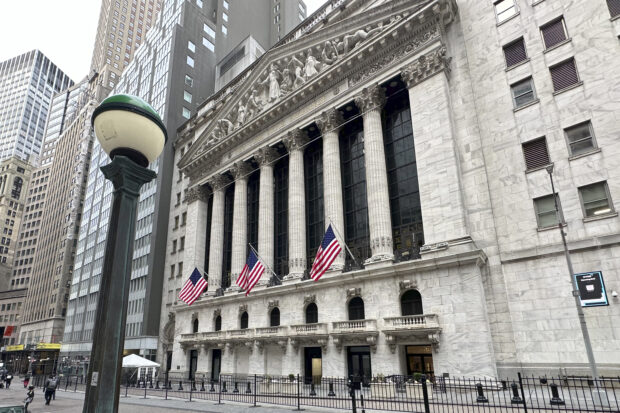Wall Street ends mostly higher after a late wave of buying

The New York Stock Exchange is shown on Wednesday, Feb. 21 2024, in New York. (AP Photo/Peter Morgan)
NEW YORK — Stocks ended mostly higher on Wall Street Wednesday after a listless day of trading with big technology stocks again acting as a heavy weight on the market.
The S&P 500 rose 6.29 points, or 0.1 percent, to 4,981.80. The benchmark index spent much of the day in losing territory before climbing higher just before markets closed.
The Dow Jones Industrial Average also eked out a slight gain after losing ground most of the day. It rose 48.44 points, or 0.1%, to 38,612.24.
The technology-heavy Nasdaq composite fell 49.91 points, or 0.3 percent, to 15,580.87.
Earnings remained the big focus for Wall Street. After markets closed, Nvidia reported earnings and revenue that handily beat Wall Street forecasts. The chipmaker has tripled over the past year thanks to a surge in investor enthusiasm over artificial intelligence.
Palo Alto Networks was a big loser and a particularly heavy weight on the tech sector. The network security company sank 28.4 percent after giving forecasts for future billings that came in well below what analysts were looking for. Rival Fortinet slumped 3.8 percent.
Amazon rose 0.9 percent following an announcement that it would be added to the Dow. Walgreens Boots Alliance, which is leaving the Dow, fell 2.5 percent.
READ: Amazon to replace Walgreens in Dow Jones Industrial Average
Bond yields gained ground. The yield on the 10-year Treasury rose to 4.33 percent from 4.28 percent late Tuesday.
Technology stocks drove much of the market’s rally that brought it to record highs just last week. The sector is also showing some of the strongest earnings growth. Lopsided contributions from some of the bigger companies in the sector, however, have raised questions about whether the gains were overdone.
“In February we’re seeing some of that settle out as we try and get a better bead on how the full year is going to go,” said Rob Haworth, senior portfolio manager at U.S. Bank Wealth Management.
Several other companies made big moves following the release of their financial results. Electronic measurement technology company Keysight Technologies fell 6.7 percent after its profit forecast fell short of analysts’ expectations. Garmin, which makes personal navigation devices, jumped 8.8 percent after beating earnings forecasts.
Toll Brothers rose 3.9 percent after giving investors an encouraging financial update as it sees strong demand. That helped support gains throughout the homebuilding sector.
Energy companies gained ground as natural gas prices jumped 12.5 percent. Exxon Mobil rose 2 percent.
The Federal Reserve released minutes from its latest meeting in January that showed most officials are worried about moving too fast to cut their benchmark interest.
READ: Fed signals ‘patience’ on rate cuts as data disappoints
The central bank left the rate alone for the fourth time in a row at that meeting. Investors have all but lost hope that the central bank will cut rates at its March meeting and are looking for the first rate cut to come in June.
Investors have to wait until next week for another key update on inflation. That’s when the government will release its monthly report on personal consumption and expenses, the Fed’s preferred measure of inflation.
The central bank’s goal has been to tame inflation back to 2 percent and analysts expect that report to show it cooled to 2.3 percent in January. Inflation by that measure peaked at 7.1 percent in June of 2022.
“As long as the labor market holds up, the Fed can afford to slow walk rate cuts,” said Jamie Cox, managing partner for Harris Financial Group. “Inflation fighting is much easier when the labor market cooperates.”
Separate measures for consumer and wholesale prices in January show that inflation didn’t cool as much as anticipated. That prompted investors to shift expectations for rate cuts from March to June.
A weak report on retail sales added to the disappointing inflation data and raised concerns that stubborn inflation is inflicting more pain on consumers. Tighter consumer spending could put more pressure on businesses in 2024.